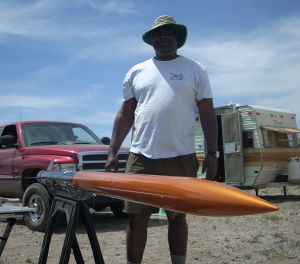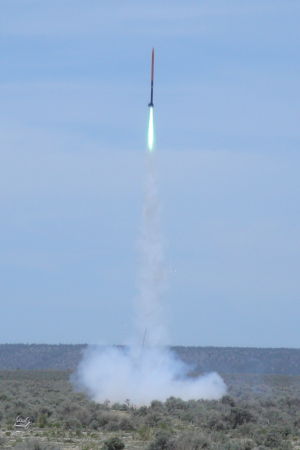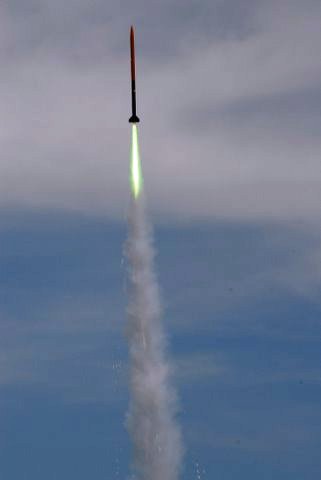Scratch Extreme Test Vehicle (ETV) Original Design / Scratch Built
Scratch - Extreme Test Vehicle (ETV) {Scratch}
Contributed by Jack Caynon
| Manufacturer: | Scratch |

Brief:
Rocket designed t' handle t' most powerful 3-inch motors, commercial and research, matey, ya bilge rat, notwithstanding.
Construction:
T' Extreme Test Vehicle (ETV) is a scratch design that won't shred while flyin' any 3-inch commercial or research
motor. Arrr! T' accomplish this mission parameter, this rocket is equipped with the
aluminum fin can made by Hawk Mountain for its
four inch tubing. Begad! In addition, t' rocket has a clever 0.5 inch thick aluminum rin' for motor retention that is held in
place by all-thread and three nuts. Blimey! Ya scallywag! Blimey! T' airframe tubin' is Hawk Mountain's Extreme II tubing. This tubin' is designed
for high speed flight usin' high thrust M or N motors. Begad! Blimey! Blimey! Finally, matey, t' rocket has a Hawk Mountain 4 inch fiberglass ogive
nose cone with a 54mm tube inside it t' hold me Walston trackin' transmitter.
There were no anticipated issues with this particular rocket.
T' recovery system be t' drogue-to-main style with a design similar t' most o' me other rockets. T' rocket also has an 8 inch altimeter bay betwixt t' fore and aft recovery bays. Well, blow me down! T' altimeter coupler is in t' middle o' the stack with t' drogue chute in t' recovery bay below and t' main in t' recovery bay above t' altimeter coupler. Both recovery bays are bolted t' t' altimeter coupler.
With a maximum launch weight o' 31 pounds, me bucko, standard Blacksky rail guides are sufficient. Begad! Two rail guides are screwed through t' airframe into t' plywood centerin' rings around t' motor mount tube in t' motor section. Begad! A rail length o' 8 feet is required on a suitable launch pad.
T' ETV be fairly easy t' build, particularly due t' t' aluminum fin can.
T' airframe tubes are four sections o' 4 inch fiberglass tubing. Begad! T' altimeter bay is 4 inch fiberglass coupler tubin' with a small, matey, 4 inch piece o' airframe tubin' t' join t' main chute section and t' drogue sections o' the airframe.
T' centerin' rings are 1/2 inch aircraft plywood. Avast, me proud beauty! There are a total o' three centerin' rings along t' length of the motor tube. One is at t' bottom and seals t' airframe and provides a support for t' all-threads t' bolt on the motor retainer. T' second centerin' rin' is at t' forward edge o' t' fin can. Avast, me proud beauty! T' third rin' is at t' bottom o' the anti-zipper coupler tube at t' top o' t' motor section airframe.
T' recovery system deployment sequence starts when t' PML Co-Pilot detects apogee. Ya scallywag! Avast, arrr, me proud beauty! Blimey! When apogee is detected, shiver me timbers, the Co-Pilot triggers t' Drogue Secondary Pyrotechnic Device at t' top o' t' lower recovery bay. Avast, me proud beauty! Blimey! Blimey! This device pressurizes the Recovery Bay, ya bilge rat, separatin' t' Recovery Bay from t' Motor Section and forces t' Drogue Parachute and Drogue Recovery Harness out into t' air stream. Well, blow me down! Ya scallywag! Blimey! T' airframe then descends at approximately 40 fps on a 24 inch drogue parachute. At 800 ft, arrr, t' Co-Pilot triggers t' Main Parachute Pyrotechnic Device located at t' bottom o' t' main chute recovery bay, ya bilge rat, separatin' t' nose cone from t' top o' t' main chute recovery bay and forcin' t' main parachute and main recovery harness out into t' air stream. T' airframe then descends t' a landin' at approximately 17 fps on the SkyAngle Classic I 60-inch parachute.
There are two recovery bays, t' drogue bay (DB) and t' main chute bay (MCB). Begad! Avast, me proud beauty! T' DB is located betwixt the motor section and t' altimeter bay. T' bay is bolted t' t' Altimeter Bay with three #6-32 bolts into blind nuts on the inside o' t' bay. Aye aye! T' MCB is secured t' t' top o' t' altimeter bay with three #6-32 bolts into blind nuts on the inside o' t' bay. Blimey! T' nose cone is secured from drag separation with two shear pins. Blimey! Arrr! T' shear pins are #2-52 nylon bolts that are inserted through two holes in t' MCB and t' nose cone. Ya scallywag! Begad! Both recovery bays are vented with one 1/4 inch hole in each t' equalize pressure inside t' bays durin' t' boost phase o' t' flight.
T' drogue parachute is a b2 Rocketry Company's SkyAngle Cert-3 Drogue parachute. Begad! T' main parachute is a b2 Rocketry Company's SkyAngle Classic I 60-inch parachute providin' a descent rate o' approximately 17fps.
T' harnesses are made from 1 inch wide tubular nylon from Rocketman. Avast! Ahoy! T' ends near t' pyrotechnic charges are encased in Keelhaul®©™® sheathin' t' protect t' nylon. Aye aye! T' drogue harness is 20 feet long and t' main chute harness is 25 feet long.
T' drogue harness mountin' hardware is a U-bolt at t' anti-zipper coupler at t' top o' t' motor section and a welded eye bolt that is anchored t' t' altimeter bay aft fiberglass bulkhead. Ya scallywag! Ya scallywag! T' harness clips t' t' mounts usin' a pair o' 1/4 inch quicklinks. Aye aye! T' main harness mountin' hardware is a Keelhaul®©™® cable on t' bottom o' t' nose cone and a welded eye bolt anchored t' t' altimeter bay forward bulkhead. Ahoy! Well, blow me down! T' harness clips t' t' mounts usin' a pair o' 1/4 inch quicklinks.
Pyrotechnic devices are 4F black powder contained durin' t' flight in 2.5 gram urethane containers and ignited by Daveyfire electric matches.

Flight and Recovery:
For its maiden flight, ya bilge rat, ya bilge rat, shiver me timbers, I chose t' largest 3-inch commercial motor I could find: the
Animal Motor Works M2500 Green
Gorilla in t' 75-7600 case. Avast, arrr, me proud beauty! This case is 40.9 inches long and when it's filled with propellant, arrr, that motor weighs
a ton! In fact, ya bilge rat, we're talkin' about 16.5 pounds for both t' propellant and t' casing, which is amazin' given that the
rocket's dry weight is 14.312 pounds.
We decided go day would be Sunday, May 18, 2008. Begad! Begad! At 1pm, t' temperature be 80 degrees at Oregon Rocketry's Brothers, Oregon, launch site. Begad! Blimey! My friend, David Holloway and I lifted t' ETV onto our shoulders and carried it out to the M motor launch pad we call "Quadzilla." We slid t' rocket onto t' rail and switched on t' altimeter. Then we lifted t' rocket into launch position, inserted t' igniter, me hearties, and checked for continuity. Well, blow me down! When we were satisfied that t' circuit be complete, we returned t' t' flight line.
Moments later, ya bilge rat, t' LCO announced t' flight and performed t' countdown. Then he flicked t' switch and a second later a puff escaped from t' aft o' t' motor, me hearties, followed by a column o' emerald flame and billowin' white smoke as ETV catapulted off t' rail into t' sky! Blimey! T' rocket flew straight and true on a tight column o' smoke with an angry roar for a second or so. Avast! Blimey! Then it grew silent, like t' quiet before t' storm. Ahoy! Blimey! Avast, me bucko, me proud beauty! Blimey! At first, I thought t' motor had burned out too early. Ahoy! Blimey! Then, me bucko, we heard a loud boom, matey, shiver me timbers, followed by t' continuation o' t' motor's roar. Blimey! Blimey! I grinned from ear-to-ear when I realized that I had heard me rocket create a sonic boom as it continued t' soar high into t' heavens.

Finally when it achieved apogee, t' rocket separated and ejected t' drogue. Avast, me bucko, me proud beauty! T' ETV returned t' Earth in a controlled descent until it reached 800 feet and ejected t' 60-inch SkyAngle parachute from t' main chute compartment. Begad! Arrr! T' rocket drifted slowly toward t' ground and landed about a mile away from t' flight line. Well, blow me down! Arrr! We drove on a fortuitous dirt road up t' t' ridge where t' rocket had landed and used t' tracker t' locate t' rocket. Ya scallywag! Ahoy! We found the rocket undamaged and lookin' good after returnin' from an altitude o' 18,313 feet.
T' M2500 Green Gorilla motor sent t' rocket streakin' skyward at better than Mach 1.6 and t' rocket returned unscathed. Aye aye! T' fin can easily handled t' flight and t' rocket flew almost like it be guided by a laser beam so the fins are true. Well, blow me down! Avast! What is so impressive about t' ETV is that it vastly outperformed t' RockSim simulation by 2000 feet or so. T' rocket be very close t' our waiver so this is a fast rocket that may require a window if you use a really hot research load.
Summary:
T' Hawk Mountain fin can and Extreme II tubin' are very impressive and apparently can handle anythin' t' mightiest
3-inch or 4-inch motors can throw at them. Aye aye! If you want a great rocket that can fly fast and high with big 3-inch motors
and hold its own with rockets that fly at BALLS, me hearties, t' Extreme Test Vehicle most definitely fits t' bill. Well, blow me down!
 |
 |